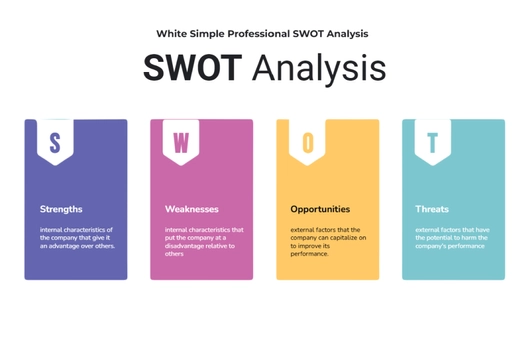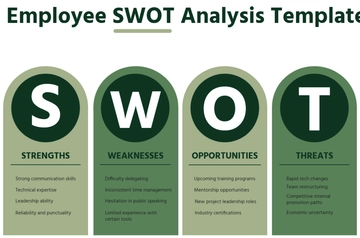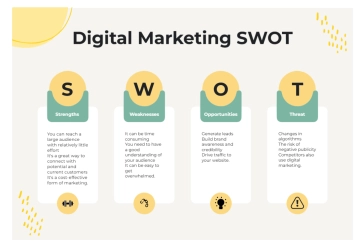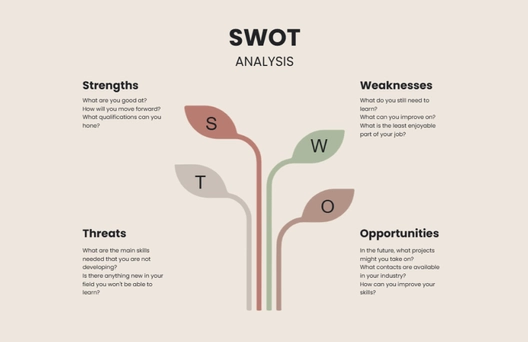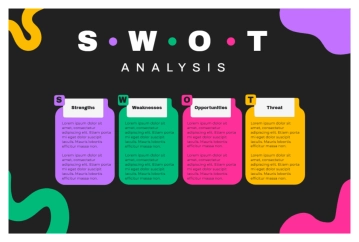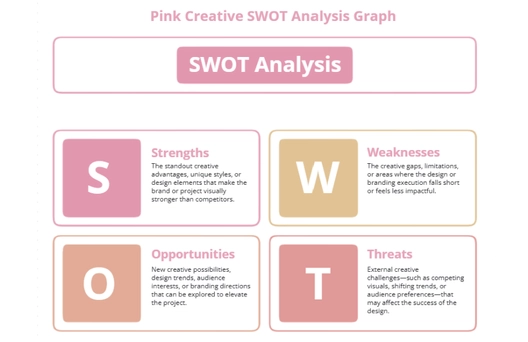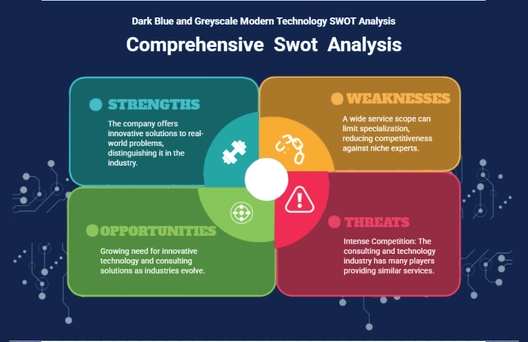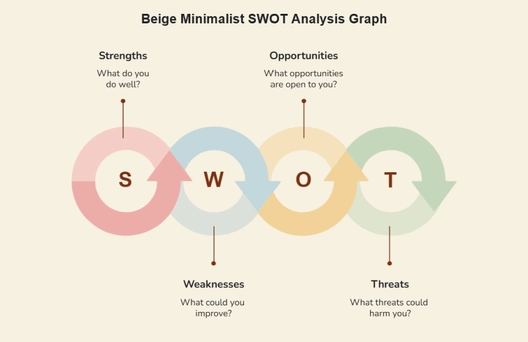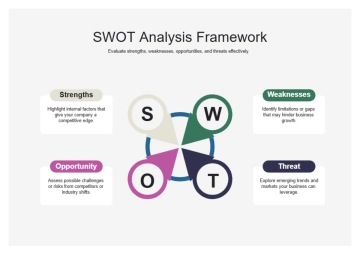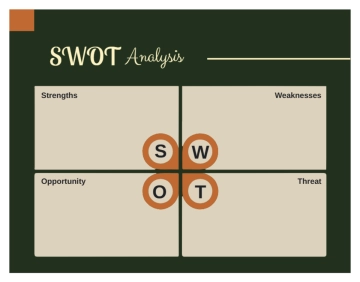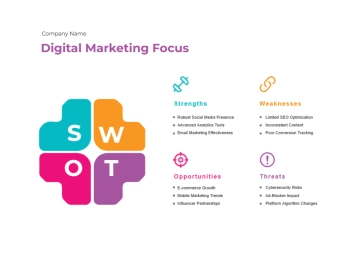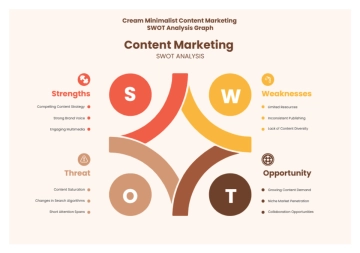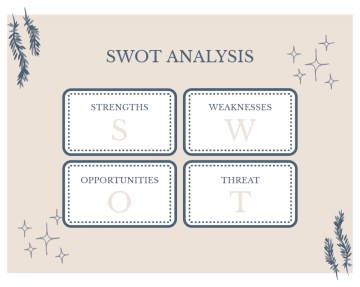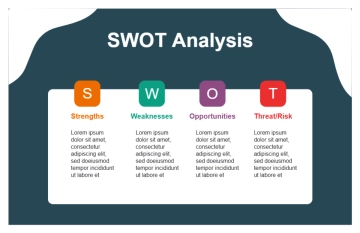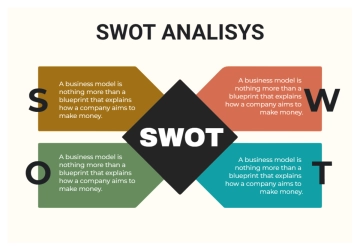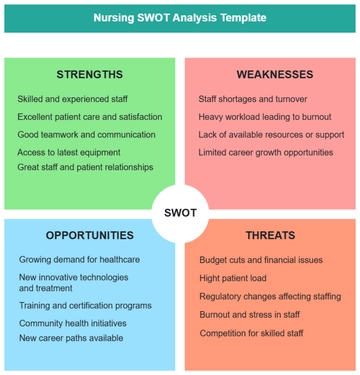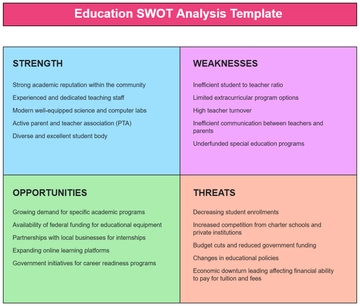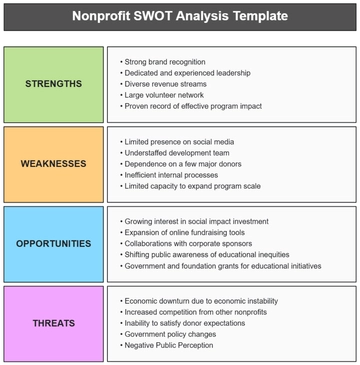Free Agriculture Environmental SWOT Analysis
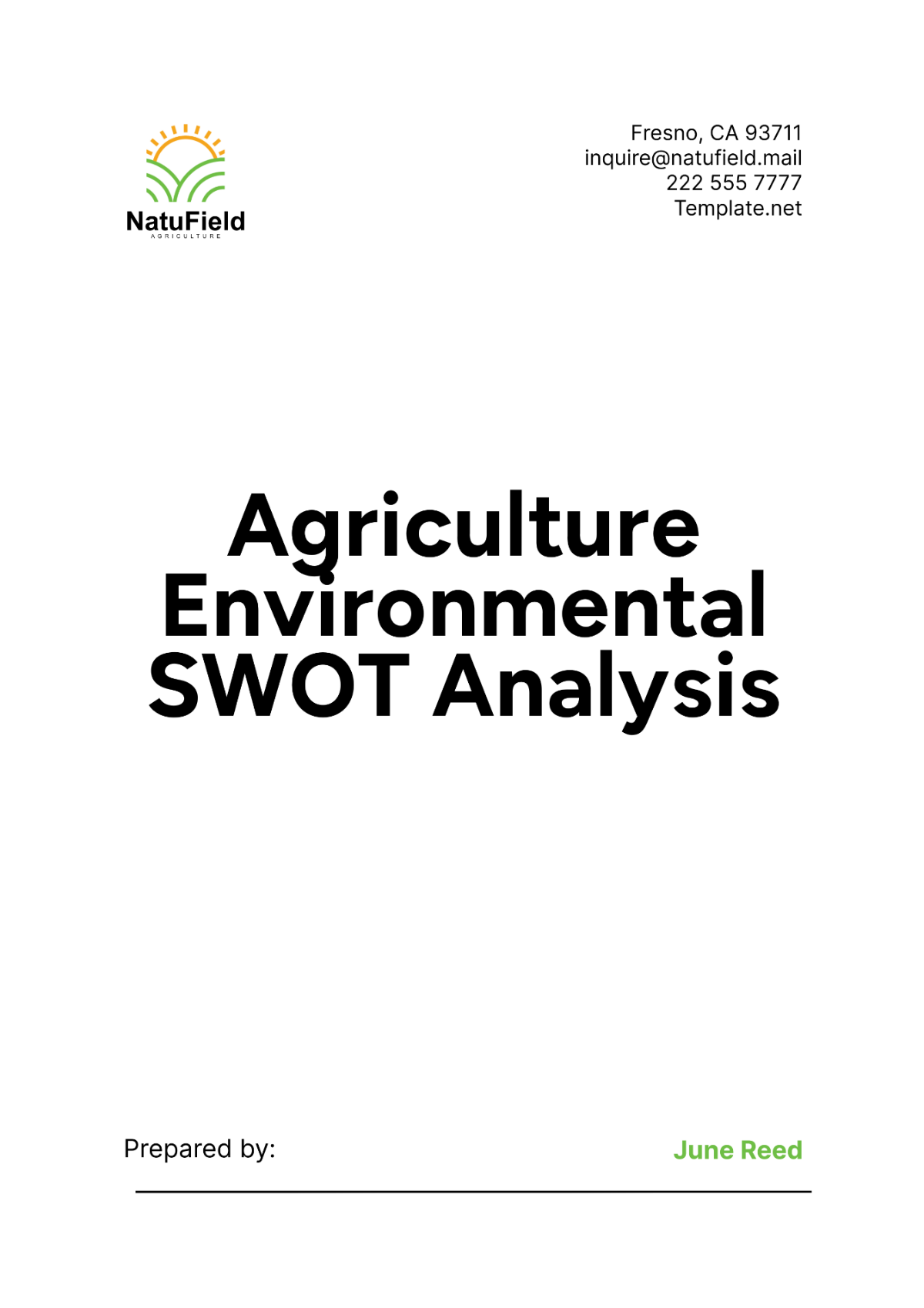
I. Introduction
Agriculture plays a pivotal role in sustaining economies and feeding populations worldwide. [Your Company Name] recognizes the profound impact agricultural practices have on the environment. To ensure sustainable growth and compliance with environmental standards, we conducted a comprehensive analysis of our strengths, weaknesses, opportunities, and threats.
This SWOT analysis is designed to provide an in-depth evaluation of our current environmental practices. By understanding our internal capabilities and external challenges, we can develop strategies that enhance our environmental stewardship while maintaining our competitive edge.
The findings of this analysis will guide our decision-making processes, helping us to implement effective environmental practices and policies. Our goal is to minimize our ecological footprint, enhance resource efficiency, and contribute positively to the environment.
II. Methodology
A. Data Collection
Internal Reports: Reviewed existing internal reports on environmental performance and compliance. These reports provided a baseline for understanding our current environmental impact.
Field Surveys: Conducted field surveys to gather data on land use, water management, waste management, and biodiversity. This data helped in assessing the practical aspects of our environmental practices.
Stakeholder Interviews: Interviewed key stakeholders, including employees, local communities, and environmental experts, to gather their perspectives on our environmental practices. Their feedback was crucial in identifying both strengths and areas for improvement.
B. Data Analysis
Comparative Analysis: Compared our environmental performance data with industry benchmarks to identify gaps and best practices. This analysis helped in setting realistic goals for improvement.
Trend Analysis: Analyzed trends in environmental data over the past five years to understand the impact of our practices over time. This analysis provided insights into areas where we have made progress and areas needing further attention.
SWOT Framework: Applied the SWOT framework to categorize our findings into strengths, weaknesses, opportunities, and threats. This structured approach ensured a comprehensive evaluation of our environmental performance.
C. Validation
Expert Review: Engaged environmental experts to review our findings and provide validation. Their insights helped in refining our analysis and ensuring its accuracy.
Community Feedback: Presented preliminary findings to local communities and gathered their feedback. This step ensured that our analysis considered the perspectives of those directly impacted by our operations.
Internal Validation: Conducted internal workshops with key departments to validate the findings and gather additional insights. This collaborative approach ensured that our analysis was thorough and representative of our organization.
III. Strengths
A. Sustainable Farming Practices
Organic Farming: Implementing organic farming practices has significantly reduced our reliance on chemical fertilizers and pesticides. This approach not only improves soil health but also enhances biodiversity.
Crop Rotation: Practicing crop rotation helps in maintaining soil fertility and reducing pest outbreaks. This sustainable method minimizes soil depletion and ensures long-term agricultural productivity.
Integrated Pest Management: Using integrated pest management techniques reduces the need for chemical interventions. This method promotes the use of natural predators and environmentally friendly pest control measures.
B. Efficient Water Management
Drip Irrigation Systems: Installing drip irrigation systems has optimized water usage by delivering water directly to plant roots. This system reduces water wastage and improves crop yield.
Rainwater Harvesting: Implementing rainwater harvesting systems has provided an additional water source, reducing our dependence on groundwater. This practice enhances water conservation and ensures water availability during dry periods.
Water Recycling: Recycling water used in agricultural processes has minimized freshwater consumption. This practice not only conserves water but also reduces the environmental impact of wastewater discharge.
C. Renewable Energy Use
Solar Power: Utilizing solar power for irrigation and other agricultural operations has reduced our reliance on non-renewable energy sources. This shift to renewable energy lowers our carbon footprint and operational costs.
Biogas Production: Producing biogas from agricultural waste provides a sustainable energy source. This practice reduces greenhouse gas emissions and promotes waste-to-energy conversion.
Wind Energy: Incorporating wind energy into our operations contributes to renewable energy use. This approach further diversifies our energy portfolio and enhances energy security.
IV. Weaknesses
A. Limited Technological Adoption
Precision Agriculture: Slow adoption of precision agriculture technologies limits our ability to optimize resource use. Investing in these technologies can enhance efficiency and reduce environmental impact.
Data Management: Inadequate data management systems hinder our ability to monitor and analyze environmental performance. Implementing robust data management solutions is essential for informed decision-making.
Automation: Limited automation in our processes leads to inefficiencies and higher resource consumption. Embracing automation can streamline operations and reduce environmental footprint.
B. Waste Management Challenges
Waste Segregation: Inadequate waste segregation practices lead to higher levels of landfill waste. Improving waste segregation can enhance recycling rates and reduce environmental pollution.
Composting Facilities: Lack of adequate composting facilities limits our ability to manage organic waste effectively. Investing in composting infrastructure can convert organic waste into valuable soil amendments.
Plastic Use: High usage of plastic in packaging and operations contributes to environmental pollution. Reducing plastic use and adopting sustainable packaging alternatives can mitigate this issue.
C. Soil Degradation
Erosion Control: Insufficient erosion control measures lead to soil loss and degradation. Implementing effective erosion control practices can preserve soil health and enhance agricultural productivity.
Soil Fertility: Over-reliance on chemical fertilizers has negatively impacted soil fertility. Adopting organic amendments and sustainable fertilization practices can restore soil health.
Land Management: Poor land management practices contribute to soil degradation. Developing comprehensive land management plans can enhance soil conservation and sustainable land use.
V. Opportunities
A. Technological Advancements
Precision Agriculture: Investing in precision agriculture technologies can optimize resource use and improve crop yields. These technologies include GPS-guided equipment, soil sensors, and remote sensing tools.
Drones and Robotics: Utilizing drones and robotics for monitoring and managing crops can enhance efficiency and reduce labor costs. These tools provide real-time data and automate routine tasks.
Artificial Intelligence: Implementing artificial intelligence (AI) solutions can improve decision-making and predictive analytics. AI can help in identifying patterns, optimizing inputs, and enhancing overall productivity.
B. Policy and Incentives
Government Grants: Accessing government grants and subsidies for sustainable farming practices can reduce financial burdens. These incentives support the adoption of environmentally friendly technologies and practices.
Regulatory Support: Strengthening compliance with environmental regulations can enhance our reputation and market access. Staying ahead of regulatory changes ensures continuous improvement and sustainability.
Collaborative Partnerships: Forming partnerships with research institutions and NGOs can provide access to resources and expertise. Collaboration can drive innovation and support environmental initiatives.
C. Market Trends
Organic Market Growth: Increasing demand for organic products presents a significant market opportunity. Expanding our organic product line can attract health-conscious consumers and enhance profitability.
Sustainable Certifications: Obtaining sustainable certifications can differentiate our products in the market. Certifications such as Fair Trade and Rainforest Alliance enhance brand credibility and consumer trust.
Eco-Friendly Packaging: Adopting eco-friendly packaging solutions can appeal to environmentally conscious consumers. Reducing plastic use and opting for biodegradable materials can enhance our market positioning.
VI. Threats
A. Climate Change
Extreme Weather Events: Increasing frequency of extreme weather events such as droughts and floods poses a significant threat to agricultural productivity. Developing resilient practices is essential for mitigating these impacts.
Temperature Fluctuations: Unpredictable temperature fluctuations can affect crop growth and yields. Implementing adaptive strategies can help in managing temperature-related risks.
Water Scarcity: Climate change-induced water scarcity threatens the availability of water for irrigation. Investing in efficient water management practices is crucial for ensuring water security.
B. Regulatory Challenges
Stringent Regulations: Increasingly stringent environmental regulations can impose compliance costs and operational constraints. Proactively adapting to regulatory changes is necessary to avoid penalties and disruptions.
Certification Requirements: Meeting certification requirements for sustainable practices can be resource-intensive. Ensuring compliance with certification standards requires continuous investment and monitoring.
Trade Barriers: Environmental regulations in export markets can create trade barriers. Navigating these regulations requires strategic planning and alignment with international standards.
C. Market Competition
Price Competition: Intense price competition in the agricultural market can pressure profit margins. Differentiating our products through quality and sustainability can mitigate this threat.
Consumer Preferences: Shifts in consumer preferences towards more sustainable products can impact demand. Staying attuned to market trends and adapting our offerings is essential for maintaining competitiveness.
Technological Disruption: Rapid technological advancements by competitors can create competitive disadvantages. Investing in innovation and staying updated with technological trends is crucial for maintaining a competitive edge.
VII. Environmental Impact Assessment
The following table summarizes the key environmental impacts of our agricultural practices, along with their significance and mitigation measures:
Environmental Impact | Significance Level | Mitigation Measures |
|---|---|---|
Soil Erosion | High | Implement contour farming and cover crops |
Water Pollution | Medium | Adopt integrated pest management |
Biodiversity Loss | High | Establish conservation areas |
Greenhouse Gas Emissions | Medium | Transition to renewable energy sources |
Resource Depletion | High | Enhance water and soil management |
A. Soil Erosion
Impact: Soil erosion significantly reduces soil fertility and agricultural productivity. It leads to the loss of topsoil, which is rich in nutrients essential for plant growth.
Mitigation: Implementing contour farming and planting cover crops can effectively control soil erosion. These practices reduce surface runoff and enhance soil structure, promoting long-term soil health.
B. Water Pollution
Impact: Agricultural runoff containing pesticides and fertilizers can contaminate water bodies, affecting aquatic ecosystems and human health. Water pollution is a significant environmental concern.
Mitigation: Adopting integrated pest management practices minimizes the use of harmful chemicals. This approach includes using biological controls and organic pesticides, reducing the risk of water contamination.
C. Biodiversity Loss
Impact: Intensive farming practices can lead to habitat destruction and biodiversity loss. This reduction in biodiversity affects ecosystem stability and resilience.
Mitigation: Establishing conservation areas and promoting agroforestry practices can enhance biodiversity. These measures provide habitats for wildlife and improve ecosystem services.
D. Greenhouse Gas Emissions
Impact: Agricultural activities contribute to greenhouse gas emissions, particularly methane and nitrous oxide. These emissions contribute to climate change and global warming.
Mitigation: Transitioning to renewable energy sources and adopting sustainable farming practices can reduce greenhouse gas emissions. Practices such as no-till farming and cover cropping also sequester carbon in the soil.
E. Resource Depletion
Impact: Over-extraction of water and soil nutrients depletes natural resources, threatening long-term sustainability. Resource depletion can lead to reduced agricultural productivity and environmental degradation.
Mitigation: Enhancing water and soil management practices ensures the sustainable use of resources. Techniques such as drip irrigation and organic fertilization improve resource efficiency and sustainability.
VIII. Recommendations
A. Enhance Technological Adoption
Invest in Precision Agriculture: Investing in precision agriculture technologies such as GPS-guided equipment and soil sensors can optimize resource use. These technologies improve efficiency, reduce environmental impact, and enhance crop yields.
Implement Data Management Systems: Developing robust data management systems to monitor and analyze environmental performance is essential. Accurate data management facilitates informed decision-making and continuous improvement.
Adopt Automation: Embracing automation in agricultural processes can streamline operations and reduce resource consumption. Automated systems enhance efficiency and minimize environmental footprint.
B. Improve Waste Management
Develop Composting Facilities: Investing in composting facilities for managing organic waste can convert waste into valuable soil amendments. Composting reduces landfill waste and enhances soil health.
Enhance Waste Segregation: Implementing effective waste segregation practices can improve recycling rates and reduce environmental pollution. Proper segregation ensures that recyclable materials are diverted from landfills.
Reduce Plastic Use: Adopting sustainable packaging alternatives and reducing plastic use can mitigate environmental pollution. Using biodegradable materials enhances sustainability and aligns with consumer preferences.
C. Strengthen Soil Conservation
Implement Erosion Control Measures: Developing comprehensive erosion control measures such as contour farming and cover cropping can preserve soil health. These practices reduce soil loss and enhance agricultural productivity.
Adopt Sustainable Fertilization Practices: Using organic amendments and sustainable fertilization practices can restore soil fertility. These practices enhance soil health and long-term agricultural sustainability.
Develop Land Management Plans: Creating detailed land management plans ensures sustainable land use and soil conservation. Effective land management enhances soil structure and productivity.
D. Explore Market Opportunities
Expand Organic Product Line: Capitalizing on the growing demand for organic products can enhance profitability. Expanding our organic product line attracts health-conscious consumers and aligns with market trends.
Obtain Sustainable Certifications: Securing sustainable certifications such as Fair Trade and Rainforest Alliance can differentiate our products in the market. Certifications enhance brand credibility and consumer trust.
Adopt Eco-Friendly Packaging: Switching to eco-friendly packaging solutions appeals to environmentally conscious consumers. Reducing plastic use and opting for biodegradable materials enhances our market positioning.
IX. Conclusion
This Agriculture Environmental SWOT Analysis of [Your Company Name] highlights the critical strengths, weaknesses, opportunities, and threats related to our agricultural practices. By leveraging our strengths and addressing our weaknesses, we can enhance our environmental performance and sustainability. The recommendations provided are designed to guide our efforts in optimizing resource use, improving waste management, and exploring market opportunities.
Implementing these strategies will not only benefit our operations but also contribute positively to the environment and surrounding communities. As we move forward, continuous monitoring and adaptation will be essential to ensure long-term sustainability and environmental stewardship. By committing to these practices, [Your Company Name] can achieve a balance between productivity and environmental responsibility, securing a sustainable future for our agricultural operations.
- 100% Customizable, free editor
- Access 1 Million+ Templates, photo’s & graphics
- Download or share as a template
- Click and replace photos, graphics, text, backgrounds
- Resize, crop, AI write & more
- Access advanced editor
Analyze your environmental strategies with our Agriculture Environmental SWOT Analysis Template! Available on Template.net, this template includes customizable fields to reflect your business branding. Fully editable, it allows you to tailor the analysis to your requirements. The AI Editor Tool ensures quick and precise creation, ensuring a tailored SWOT analysis!
